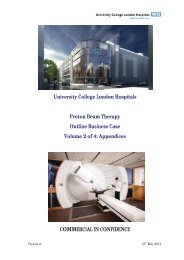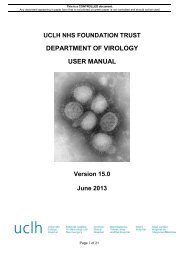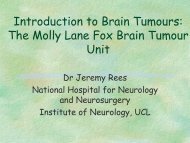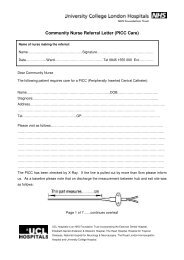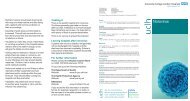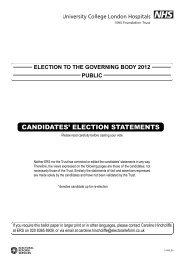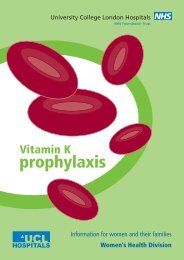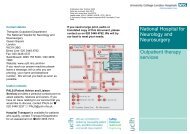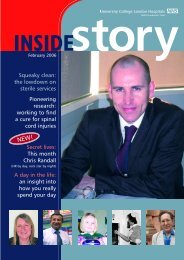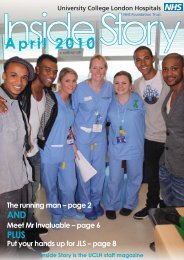How patients have helped us with our research - University College ...
How patients have helped us with our research - University College ...
How patients have helped us with our research - University College ...
You also want an ePaper? Increase the reach of your titles
YUMPU automatically turns print PDFs into web optimized ePapers that Google loves.
46 UCLH BIOMEDICAL RESEARCH UNIT<br />
Joining forces to pioneer gene therapy<br />
A unique partnership between<br />
<strong>patients</strong>, a charity and UCL<br />
<strong>research</strong>ers is helping doctors<br />
look for a way of ending the<br />
misery of haemophilia B.<br />
Haemophilia is a clotting<br />
disorder which ca<strong>us</strong>es<br />
unpredictable and spontaneo<strong>us</strong><br />
internal bleeding. A person <strong>with</strong><br />
haemophilia B has a genetic<br />
defect and their liver is unable<br />
to manufacture a protein called<br />
‘factor 9’. Factor 9 is essential<br />
for clotting.<br />
Excitingly, a team from the<br />
Haematology Department at<br />
the UCL Cancer Institute has<br />
been pioneering a technique<br />
to correct the genetic defect.<br />
But clinical <strong>research</strong>ers could<br />
not <strong>have</strong> got this far <strong>with</strong>out<br />
funding from a charity,<br />
volunteers and extensive patient<br />
consultation.<br />
Patients say what<br />
they want<br />
To correct the genetic defect,<br />
a normal copy of the factor<br />
9 gene needs to be delivered<br />
safely to the liver of the patient<br />
<strong>with</strong> haemophilia B. It took the<br />
UCL team 10 years to develop<br />
a suitable vehicle – known as a<br />
vector – for carrying the genetic<br />
material.<br />
Researchers could<br />
not <strong>have</strong> got this far<br />
<strong>with</strong>out patient input<br />
But they couldn’t <strong>have</strong> done<br />
this <strong>with</strong>out funding from<br />
organisations like the Katharine<br />
Dormandy Tr<strong>us</strong>t. With gene<br />
therapy the next big thing<br />
in haemophilia <strong>research</strong>, the<br />
charity funded the original work<br />
that enabled the trial to start.<br />
Patient feedback was then<br />
crucial in helping <strong>research</strong>ers<br />
develop the gene therapy.<br />
“Initially we were going to<br />
inject the vector into the blood<br />
vessels serving the liver, but<br />
this required a small operation,<br />
and <strong>patients</strong> told <strong>us</strong> they didn’t<br />
want that. They already treat<br />
themselves by injecting factor<br />
9 into a peripheral vein, so<br />
we <strong>us</strong>ed that route instead,”<br />
says lead <strong>research</strong>er, Dr Amit<br />
Nathwani, who is from UCL and<br />
works at the haemophilia and<br />
haemostasis unit at the Royal<br />
Free Hampstead NHS Tr<strong>us</strong>t.<br />
Similarly the vehicle initially<br />
<strong>us</strong>ed by <strong>research</strong>ers was a<br />
harmless adeno associated vir<strong>us</strong><br />
(AAV) that is so common most<br />
people are immune to it and<br />
the body’s immune defences<br />
would normally attack it. To<br />
avoid this, there were two<br />
options: either <strong>us</strong>e suppressant<br />
drugs or modify the vector.<br />
Patients didn’t want to take<br />
the drugs, so the AAV type was<br />
changed to a less common one<br />
and its DNA altered.<br />
Other hurdles<br />
But even <strong>with</strong> the biological<br />
hurdles overcome, it was a<br />
challenge to get a trial off the<br />
ground. Previo<strong>us</strong> problems<br />
<strong>with</strong> haemophilia treatment,<br />
including HIV-contaminated<br />
blood products, meant <strong>patients</strong><br />
and doctors were wary of new<br />
treatments.<br />
The Katharine Dormandy Tr<strong>us</strong>t<br />
played a key role by running<br />
foc<strong>us</strong> groups for doctors to<br />
explain the trial’s objectives and



